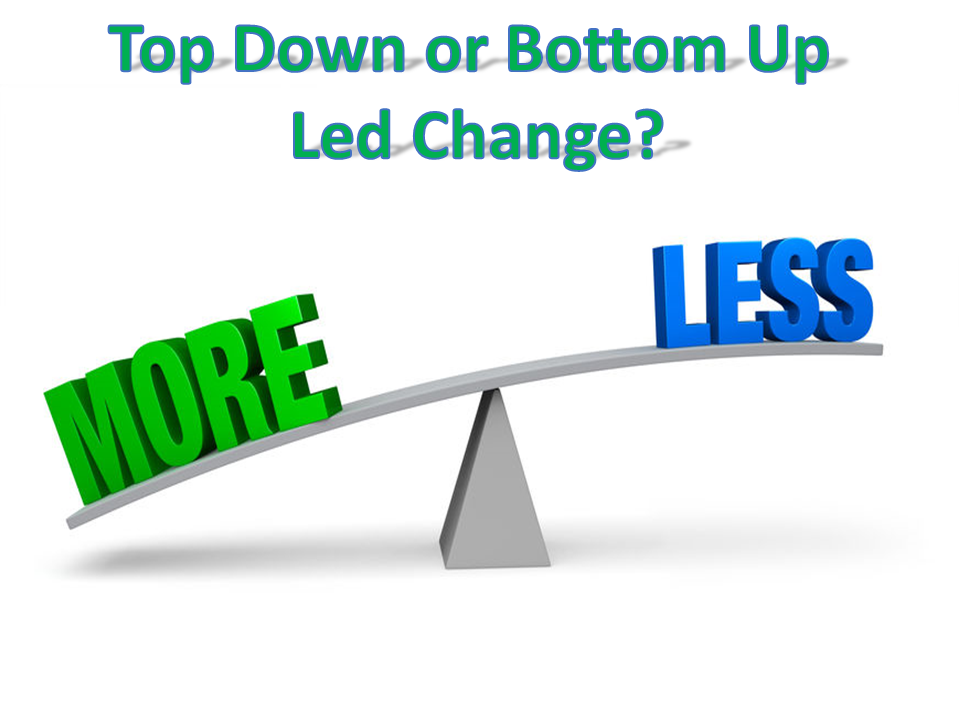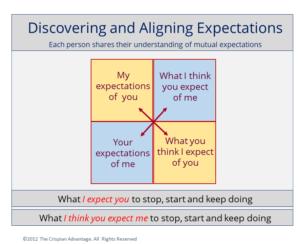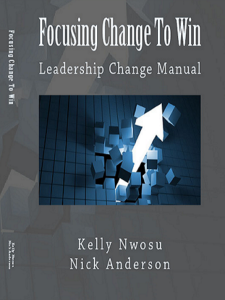
Why is building productive relationships so important?
As Terry Merriman says, “Performance is Personal Before it is Organizational”. None of us work in a vacuum. Improved workplace performance requires productive relationships with peers, bosses, subordinates, customers, clients, vendors, suppliers, and the community. Ideally, your approach to change is personal! You make sure your team members buy into it, own it, implement it, and are rewarded for it in their work relationships. Yet, in times of crisis, we still see many leaders using Top Down Change as the default approach without considering the impact on productive relationships.
In our survey of 1072 business leaders, Focusing Change to Win contributors indicate that their organizations change at least annually. These changes are often unique to their organization from the triggers for change to how it’s managed. Yet, all change has three things in common.
Benefits of Productive Relationships
- Greater clarity and trust
- Increased competitive agility
- Faster decision making
- Progress metrics focus on what really matters
- Greater confidence in doing the right things right
- Accelerated performance towards people’s potential
- Improved extent and quality of delegation
- Better motivation as people know what success looks like
Three Common Elements of Change
Identify what you expect people to stop doing.
Specify what you expect people to start doing.
Confirm what you want people to continue doing.
Then, focus on repeatedly communicating:
Why change
What is expected and
What the change is not
This is the Change Expectations Framework which engages deeper understanding and helps everyone manage stress more effectively.
Just in case you think everyone does these three steps, you are probably wrong at least 70% of the time, according to studies over the last 10 years.
The crucial step, and often missed step, is facilitating feedback from your stakeholders. What they want you to start, stop and continue doing in return. You have the responsibility to set the Expectations Framework but the what and how of change comes down to aligning expectations. Then people can:
- KNOW WHAT MATTERS
- DELIVER WHAT MATTERS
- TAKE RESPONSIBILITY FOR WHAT MATTERS
How do you reconcile this approach with a top-down approach?
Not easily. From our survey, which is the basis for our book Focusing Change to Win, you can see these business leaders’ Change Focus.
 You can see why their people feel it is still top down approach.
You can see why their people feel it is still top down approach.
A top-down approach to change management implies imposed change as the initiative comes from the top. Decision-making is centralized at higher levels of the firm, excluding lower-level employees in the change process, even though they are directly affected.
Top-down change is about making changes quickly and dealing with the problems only if necessary. The problem is that top down approaches to change management increases resistance.
The biggest problem in changing any organization is resistance to change. Where the leader makes all the decisions and expects subordinates to follow creates resistance to change. Regardless of how well these top level decisions are made, successful change is stunted because they ignore so much of the organization. Naturally, people who are forced to adapt to change have the initial reaction to resist.
What are other limitations of this top down approach?
 Change based on unidirectional, rational and traditional approaches have very definite limitations. Problems to this approach include:
Change based on unidirectional, rational and traditional approaches have very definite limitations. Problems to this approach include:
(1) Decision-making is limited to the top of the organization, therefore a lack of information, suggestions and ideas coming from the bottom;
(2) People at the top are not willing to listen to lower level employees’ ideas, suggestions or feedback, resulting to poor employee motivation and performance;
(3) There is very little task delegation involved in the change process, thus lower level employees can feel they are somehow incompetent and under qualified for such tasks;
(4) Keeping the change process to the upper level of the organization, breeds skepticism from amongst the lower level people;
(5) Misunderstandings because of communication problems and inadequate information of both parties;
(6) Many differing assessments to a given situation exist in lower levels and different functions. These employees have little chance to participate, do not know for sure the exact circumstances revolving around the change, and thus resist it.
Finally, the limitations of top-down change are too often symptoms of leaders clinging to the belief that power, privilege and success lie in their core group.
Have you got an example of this top down approach and why it failed?
In previous programs I have often quoted software development and systems implementation problems. E.G. Only 7% of US Department of Defense software projects were implemented and used as intended. But, closer to home, we partnered with Salient Technologies to get a job shop scheduling system operational.
The history was a litany of missed deadlines and budget overruns. Crucially, only a few people had been consulted on what the issues were in overcoming bottlenecks and wastage. The system was seen as idealistic at best and difficult to use. Compounding the users skepticism was the positioning and training on how to use the PC’s on the shop floor. Employees resisted mightily, avoiding training and blaming the new application for their frustration. Consequently, $400,000 later, and with only one person using the system, we were asked to get the system operable and used by all those of the factory floor.
We based our approach on fast participative cycles of “Think, Do, Fix” involving representatives of the different user groups. Each week we teased out the problems and prioritized them by biggest return and what we could deliver by the next meeting. The PIT – Performance Improvement Teams had the budget and authority to make decisions. Classically this was Action Learning at its best. Within six seeks we had the system operational and being used by some 50 users across the five lines of business.
So, this was bottom up rescuing a failed top down approach. Why don’t leaders use a bottom up approach all the time?
Bottom-up change management seeks to involve those affected in the process of change. This approach seeks to avoid the pitfalls of imposed change by allowing individuals within their working groups to come to terms with change. Bottom-up is often associated with an emergent change process like trends in technology demand rethinking what markets do we want to play-in and with what technology.
This approach typically runs into several problems being too slow to respond effectively to short-term business demands. When change initiatives come from the grass roots it takes a considerable amount of time to propagate the change throughout the organization, particularly to the higher-ups. In essence, this approach is based on collective decision-making.
Why is it so time intensive?
Time problems with this approach vary. For example:
1. There is an inevitable mismatch at the point where the bottom-up change process meets the top levels of the organization, where a different process has been at work.
2. The lower levels lack strategic perspective, thus running the risk of making people more effective at performing the wrong work.
3. Being a lengthy approach, it requires substantial energy from outside the organization to get it started. There is also the difficulty of incorporating all the perspectives and knowledge into a new system to be embedded.
4. A bottom-up approach raises questions about the motivation and skill of employees to develop an ambitious solution that will force them to change their ways.
5. Participative approaches to change can be derailed by resistant managers, unions, and workers, further lengthening the process of change.
6. Collective decision-making is by nature a lengthy process as compared to those decisions made by only a few select people.
The New York Stock Exchange (NYSE) merged with Archipelago Holdings and the management’s decision to inform its members about the merger agreement was top down. Their reasoning was that the change at NYSE is first and foremost institutional. Institutional changes are usually motivated by some sort of landmark event(s) which put the higher management in motion. Secondly, a prompt, top-down approach was practical: the gradual, bottom-up approach was a worn-out path that had steadily failed in the past. Talks to take the NYSE public and transform it into a for-profit entity—in order to give it a more effective management and governance structure—started long ago, but yielded no results.
If you were a senior executive, which approach would you take and in what circumstances?
Under critical situations, a top-down approach is appropriate. Crisis calls for immediate and fast solutions, which is exactly what a top-down approach offers. In these situations, once the plan is defined by the top management, there is no turning back, as there is only one bullet in the gun, meaning only one chance to implement it. If there is great pressure to produce quick results, the organization can be paternalistic towards its employees who would more likely be reduced to helpless recipients of a crisis. Where employees are given directions and specific paths to follow and the employees are expected to follow exactly as told, without disagreement. This would make use of valuable time for vital activities rather than spending time gathering the various ideas from the lower level of the organization and consolidating them into one functioning whole.
When objectives are high, time is short and only few elements are currently available, top down is the suitable approach to change management. If the company does not want to be overrun by irrelevant details brought about by a participative decision-making advocated by the bottom-up approach, and especially in situations where timing is crucial to the success of implementing change, it is best that the organization adapt a top-down approach to change management. With the quick nature of decision-making required of a crisis situation which is characteristic of the top-down approach.
When is a bottom up approach more appropriate?
 Where innovation is needed, bottom-up is more appropriate in change management. Innovation is essentially participative, and relies on a variety of ideas by involving everyone in the organization. When such wealth of information is needed, matching the ideas from at the lower level and those from the Leadership, make for collective decision-making. It breeds an atmosphere of innovation within the company, making it easier to pave way for change inside it.
Where innovation is needed, bottom-up is more appropriate in change management. Innovation is essentially participative, and relies on a variety of ideas by involving everyone in the organization. When such wealth of information is needed, matching the ideas from at the lower level and those from the Leadership, make for collective decision-making. It breeds an atmosphere of innovation within the company, making it easier to pave way for change inside it.
In allowing everyone in the firm to participate in the change process, there are naturally various sources of information at hand that the top level managers can bring into one useful and innovative whole. When collective decision-making is supported, people are tasked with the responsibility of contributing anything he or she can for the betterment of the company, thereby carrying everyone on the crest of success
How do you use these two approaches together?
These two approaches are ineffective by themselves. Breakthrough improvements in performance can only be achieved by blending these two. It’s a question of how you blend them. Top-down direction setting creates focus and the conditions for performance improvement. It then needs to be blended with a broad-based, bottom-up performance improvement to get people at all levels to take a fresh approach to solving problems and improving performance.
There is no ‘one best way’ for all organizations. Structure, and therefore performance, is dependent upon the particular circumstances, situational variables, faced by each organization. There is a balance between top-down and bottom-up, which will require careful thought by managers. Although top-down efforts create the focus and the necessary preconditions for transformational change, they alone are not sufficient to achieve it. It would be more accurate to say that change should be initiated bottom-up and sustained top down.
Other Related Posts
Strategic Synchronization – The First Step to Aligning Your Organization
Managing Change in a Time of Crisis
Need Help in Getting Your People on the Same Page? 
Ask Nick Anderson, co-author of Focusing Change to Win.
© Copyright. All Rights Reserved, The Crispian Advantage. Unauthorized use and/or duplication of this material without express and written permission from this blog’s author and/or owner is strictly prohibited. Excerpts and links may be used, provided that full and clear credit is given to Nick Anderson, The Crispian Advantage and Walk the Talk – A Blog for Agile Minds with appropriate and specific direction to the original content.

